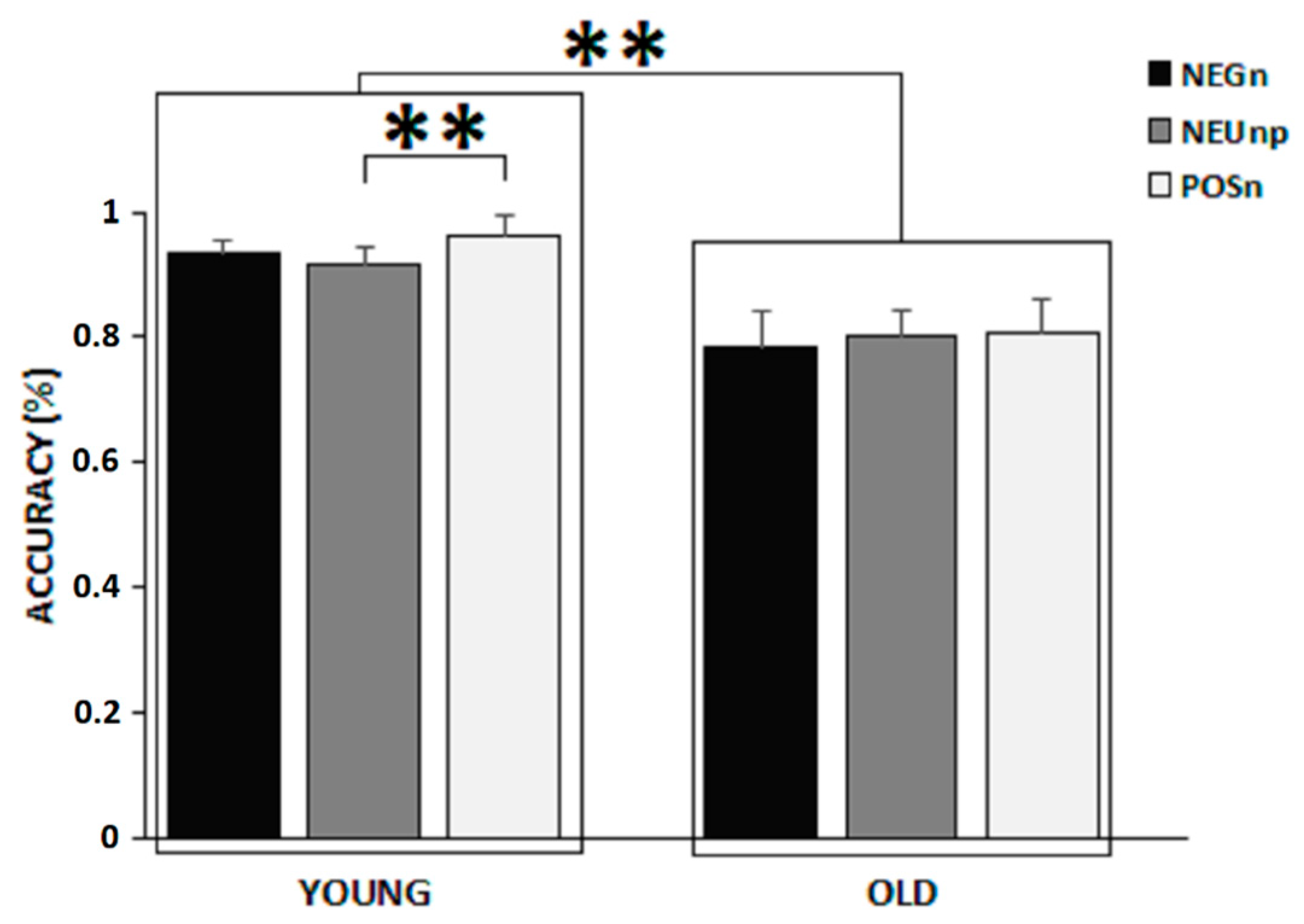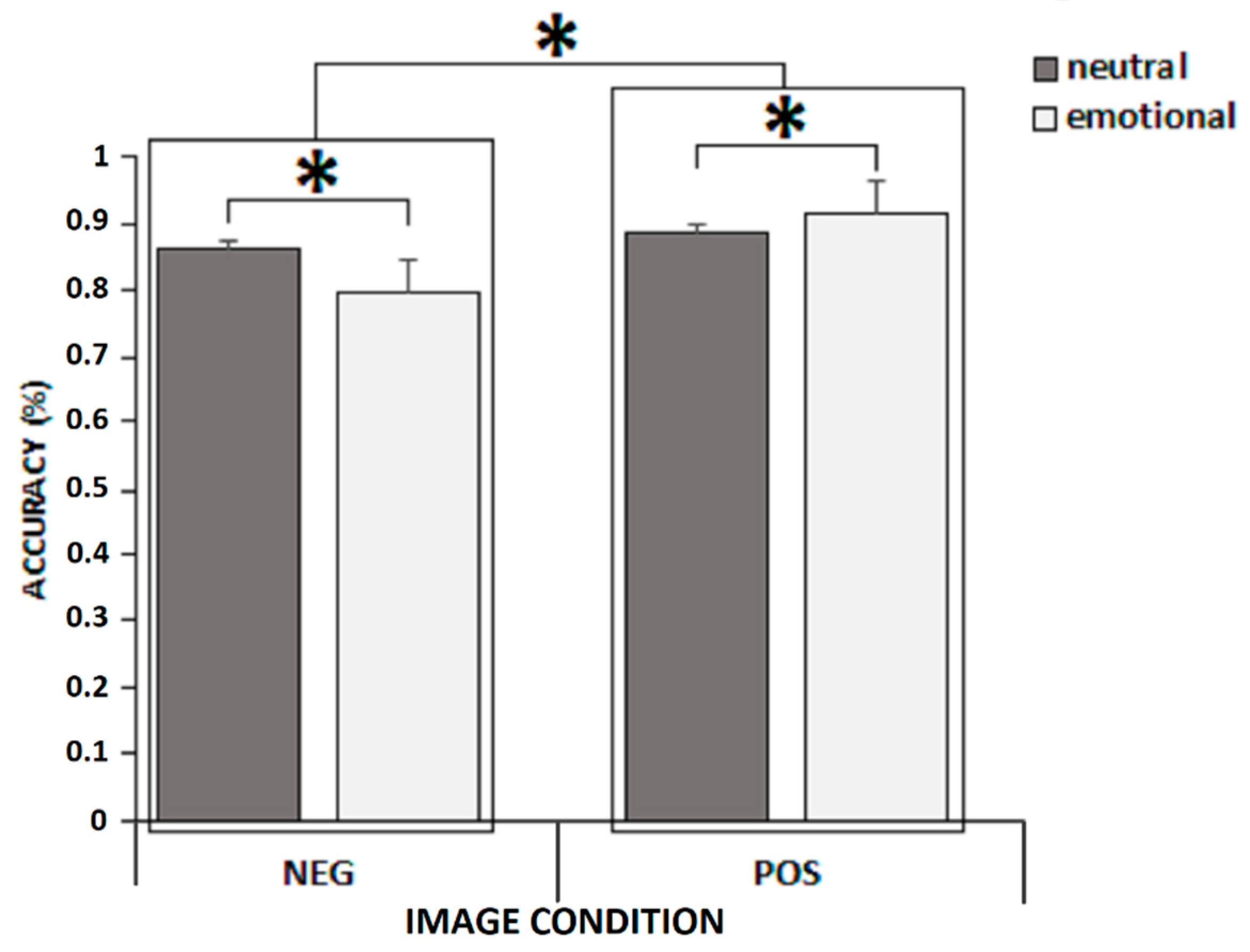Do Older and Younger Adults Prefer the Positive or Avoid the Negative?
Abstract
:1. Introduction
2. Materials and Methods
2.1. Participants
2.2. Materials
2.3. Experimental Task and Procedures
3. Results
3.1. Accuracy
3.2. RTs
4. Discussion
Author Contributions
Funding
Institutional Review Board Statement
Informed Consent Statement
Data Availability Statement
Acknowledgments
Conflicts of Interest
References
- Carstensen, L.L.; Mikels, J.A. At the Intersection of Emotion and Cognition: Aging and the Positivity Effect. Curr. Dir. Psychol. Sci. 2005, 14, 117–121. [Google Scholar] [CrossRef]
- Mather, M.; Carstensen, L.L. Aging and motivated cognition: The positivity effect in attention and memory. Trends Cogn. Sci. 2005, 9, 496–502. [Google Scholar] [CrossRef] [PubMed]
- Mather, M. The Affective Neuroscience of Aging. Annu. Rev. Psychol. 2016, 67, 213–238. [Google Scholar] [CrossRef] [PubMed] [Green Version]
- Reed, A.E.; Carstensen, L.L. The Theory behind the Age-Related Positivity Effect. Front. Psychol. 2012, 3, 339. [Google Scholar] [CrossRef] [Green Version]
- Mather, M.; Carstensen, L.L. Aging and Attentional Biases for Emotional Faces. Psychol. Sci. 2003, 14, 409–415. [Google Scholar] [CrossRef]
- Tomaszczyk, J.C.; Fernandes, M.A. Age-related differences in attentional bias for emotional faces. Aging Neuropsychol. Cogn. 2013, 21, 544–559. [Google Scholar] [CrossRef]
- Löckenhoff, C.E.; Carstensen, L.L. Aging, emotion, and health-related decision strategies: Motivational manipulations can reduce age differences. Psychol. Aging 2007, 22, 134–146. [Google Scholar] [CrossRef]
- Carstensen, L.L.; Isaacowitz, D.M.; Charles, S.T. Taking time seriously: A theory of socioemotional selectivity. Am. Psychol. 1999, 54, 165–181. [Google Scholar] [CrossRef]
- Mather, M.; Knight, M. Goal-directed memory: The role of cognitive control in older adults’ emotional memory. Psychol. Aging 2005, 20, 554–570. [Google Scholar] [CrossRef] [Green Version]
- Fairfield, B.; Mammarella, N.; Di Domenico, A. Centenarians’ “holy” memory: Is being positive enough? J. Genet. Psychol. 2013, 174, 42–50. [Google Scholar] [CrossRef]
- Labouvie-Vief, G. Dynamic integration theory: Emotion, cognition, and equilibrium in later life. In Handbook of Theories of Aging; Springer Publishing Company: Berlin/Heidelberg, Germany, 2007; pp. 277–293. [Google Scholar]
- Cacioppo, J.T.; Hawkley, L.C.; Norman, G.J.; Berntson, G.G. Social isolation. Ann. N. Y. Acad. Sci. 2011, 1231, 17–22. [Google Scholar] [CrossRef] [PubMed]
- Kennedy, B.L.; Huang, R.; Mather, M. Age differences in emotion-induced blindness: Positivity effects in early attention. Emotion 2020, 20, 1266–1278. [Google Scholar] [CrossRef] [PubMed]
- Gronchi, G.; Righi, S.; Pierguidi, L.; Giovannelli, F.; Murasecco, I.; Viggiano, M. Automatic and controlled attentional orienting in the elderly: A dual-process view of the positivity effect. Acta Psychol. 2018, 185, 229–234. [Google Scholar] [CrossRef] [PubMed]
- Sedek, G.; Hess, T.; Touron, D. Multiple Pathways of Cognitive Aging: Motivational and Contextual Influences; Oxford University Press: Oxford, UK, 2021. [Google Scholar]
- Phelps, E.A.; Ling, S.; Carrasco, M. Emotion Facilitates Perception and Potentiates the Perceptual Benefits of Attention. Psychol. Sci. 2006, 17, 292–299. [Google Scholar] [CrossRef] [Green Version]
- Herrmann, K.; Montaser-Kouhsari, L.; Carrasco, M.; Heeger, D.J. When size matters: Attention affects performance by contrast or response gain. Nat. Neurosci. 2010, 13, 1554–1559. [Google Scholar] [CrossRef]
- Mogg, K.; Bradley, B.P.; Dixon, C.; Fisher, S.; Twelftree, H.; McWilliams, A. Trait anxiety, defensiveness and selective processing of threat: An investigation using two measures of attentional bias. Pers. Individ. Differ. 2000, 28, 1063–1077. [Google Scholar] [CrossRef]
- Mather, M. The emotion paradox in the aging brain. Ann. N. Y. Acad. Sci. 2012, 1251, 33–49. [Google Scholar] [CrossRef]
- Orgeta, V. Avoiding Threat in Late Adulthood: Testing Two Life Span Theories of Emotion. Exp. Aging Res. 2011, 37, 449–472. [Google Scholar] [CrossRef]
- Nashiro, K.; Sakaki, M.; Mather, M. Age Differences in Brain Activity during Emotion Processing: Reflections of Age-Related Decline or Increased Emotion Regulation? Gerontology 2012, 58, 156–163. [Google Scholar] [CrossRef] [Green Version]
- Lee, L.O.; Knight, B.G. Attentional bias for threat in older adults: Moderation of the positivity bias by trait anxiety and stimulus modality. Psychol. Aging 2009, 24, 741–747. [Google Scholar] [CrossRef] [Green Version]
- Lang, P.J. International Affective Picture System (IAPS): Affective Ratings of Pictures and Instruction Manual. Technical Report. 2005. Available online: http://ci.nii.ac.jp/naid/20001061266/en/ (accessed on 30 July 2007).
- Britton, J.C.; Taylor, S.; Sudheimer, K.D.; Liberzon, I. Facial expressions and complex IAPS pictures: Common and differential networks. NeuroImage 2006, 31, 906–919. [Google Scholar] [CrossRef] [PubMed]
- Cattell, R.B.; Cattel, A.K.S. Culture-Fair Intelligence Test; Institute for Personality and Ability Testing: Champaign, IL, USA, 1973. [Google Scholar]
- Folstein, M.F.; Folstein, S.E.; McHugh, P.R. “Mini-mental state”. A practical method for grading the cognitive state of patients for the clinician. J. Psychiatr. Res. 1975, 12, 189–198. [Google Scholar] [CrossRef]
- Spinnler, H.; Tognoni, G. Test di ripetizione seriale di parole bisillabiche. Standardizzazione e Taratura Italiana Di Test Neuropsicologici. Ital. J. Neurol. Sci. 1987, 6 (Suppl. 8), 1–120. [Google Scholar]
- Balsamo, M.; Innamorati, M.; Van Dam, N.T.; Carlucci, L.; Saggino, A. Measuring anxiety in the elderly: Psychometric properties of the state trait inventory of cognitive and somatic anxiety (STICSA) in an elderly Italian sample. Int. Psychogeriatr. 2015, 27, 999–1008. [Google Scholar] [CrossRef] [PubMed] [Green Version]
- Balsamo, M.; Saggino, A. Determining a diagnostic cut-off on the Teate Depression Inventory. Neuropsychiatr. Dis. Treat. 2014, 10, 987–995. [Google Scholar] [CrossRef] [Green Version]
- American Psychiatric Association. Diagnostic and Statistical Manual of Mental Disorders, 5th ed.; American Psychiatric Publishing: Washington, DC, USA, 2014. [Google Scholar]
- Balsamo, M.; Saggino, A. Test per l’assessment della depressione nel contesto italiano: Un’analisi critica. Psicoter. Cogn. Comport. 2013, 13, 167. [Google Scholar]
- Grühn, D.; Scheibe, S. Age-related differences in valence and arousal ratings of pictures from the International Affective Picture System (IAPS): Do ratings become more extreme with age? Behav. Res. Methods 2008, 40, 512–521. [Google Scholar] [CrossRef] [Green Version]
- Lang, P.J.; Bradley, M.M. International Affective Picture System (IAPS): Technical Manual and Affective Ratings. NIMH Cent. Study Emot. Atten. 1997, 1, 39–58. [Google Scholar]
- Libkuman, T.M.; Otani, H.; Kern, R.; Viger, S.G.; Novak, N. Multidimensional normative ratings for the International Affective Picture System. Behav. Res. Methods 2007, 39, 326–334. [Google Scholar] [CrossRef] [Green Version]
- Bradley, M.M.; Lang, P.J. Measuring emotion: Behavior, feeling, and physiology. In Cognitive Neuroscience of Emotion; Lang, P.J., Nadel, L., Eds.; Series in Affective Science; Oxford University Press: New York, NY, USA, 2000; pp. 242–276. [Google Scholar]
- Mikels, J.A.; Fredrickson, B.L.; Samanez-Larkin, G.; Lindberg, C.M.; Maglio, S.J.; Reuter-Lorenz, P.A. Emotional category data on images from the international affective picture system. Behav. Res. Methods 2005, 37, 626–630. [Google Scholar] [CrossRef]
- Charles, S.T.; Mather, M.; Carstensen, L.L. Aging and emotional memory: The forgettable nature of negative images for older adults. J. Exp. Psychol. Gen. 2003, 132, 310–324. [Google Scholar] [CrossRef] [PubMed]
- Mammarella, N.; Di Domenico, A.; Palumbo, R.; Fairfield, B. When green is positive and red is negative: Aging and the influence of color on emotional memories. Psychol. Aging 2016, 31, 914–926. [Google Scholar] [CrossRef] [PubMed] [Green Version]
- Borella, E.; Carretti, B.; De Beni, R. Working memory and inhibition across the adult life-span. Acta Psychol. 2008, 128, 33–44. [Google Scholar] [CrossRef] [PubMed]
- Mammarella, N.; Borella, E.; Carretti, B.; Leonardi, G.; Fairfield, B. Examining an emotion enhancement effect in working memory: Evidence from age-related differences. Neuropsychol. Rehabil. 2013, 23, 416–428. [Google Scholar] [CrossRef]
- Kensinger, E.A.; Brierley, B.; Medford, N.; Growdon, J.H.; Corkin, S. Effects of normal aging and Alzheimer’s disease on emotional memory. Emotion 2002, 2, 118–134. [Google Scholar] [CrossRef]
- Elliot, A.J. The Hierarchical Model of Approach-Avoidance Motivation. Motiv. Emot. 2006, 30, 111–116. [Google Scholar] [CrossRef]
- Phaf, R.H.; Mohr, S.E.; Rotteveel, M.; Wicherts, J. Approach, avoidance, and affect: A meta-analysis of approach-avoidance tendencies in manual reaction time tasks. Front. Psychol. 2014, 5, 378. [Google Scholar] [CrossRef] [Green Version]




| Groups | ||||
|---|---|---|---|---|
| Younger—n = 50 | Older—n = 50 | |||
| Mean | SD | Mean | SD | |
| Gender (M/F) | 9/41 | 15/35 | ||
| Age (years) | 21.2 | 1.9 | 70.3 | 6.2 |
| Years Education * | 15.2 | 1.1 | 6.9 | 2.8 |
| Culture Fair | 24.0 | 4.1 | - | - |
| Raven | - | - | 24.4 | 3.3 |
| MMSE | - | - | 27.4 | 1.2 |
| STICSA Trait | 34.6 | 7.4 | 33.8 | 6.8 |
| STICSA State | 30.5 | 6.2 | 32.5 | 6.6 |
| TDI | 44.5 | 8.9 | 48.6 | 9.2 |
| NEGnu M ± SD | NEGpo M ± SD | NEUne M ± SD | NEUpo M ± SD | POSnu M ± SD | POSne M ± SD | |
|---|---|---|---|---|---|---|
| YOUNG | 0.934 ± 0.04 | 0.871 ± 0.06 | 0.926 ± 0.04 | 0.913 ± 0.04 | 0.964 ± 0.04 | 0.971 ± 0.04 |
| OLD | 0.787 ± 0.20 | 0.718 ± 0.21 | 0.805 ± 0.20 | 0.803 ± 0.21 | 0.808 ± 0.21 | 0.857 ± 0.19 |
Publisher’s Note: MDPI stays neutral with regard to jurisdictional claims in published maps and institutional affiliations. |
© 2022 by the authors. Licensee MDPI, Basel, Switzerland. This article is an open access article distributed under the terms and conditions of the Creative Commons Attribution (CC BY) license (https://creativecommons.org/licenses/by/4.0/).
Share and Cite
Fairfield, B.; Padulo, C.; Bortolotti, A.; Perfetti, B.; Mammarella, N.; Balsamo, M. Do Older and Younger Adults Prefer the Positive or Avoid the Negative? Brain Sci. 2022, 12, 393. https://doi.org/10.3390/brainsci12030393
Fairfield B, Padulo C, Bortolotti A, Perfetti B, Mammarella N, Balsamo M. Do Older and Younger Adults Prefer the Positive or Avoid the Negative? Brain Sciences. 2022; 12(3):393. https://doi.org/10.3390/brainsci12030393
Chicago/Turabian StyleFairfield, Beth, Caterina Padulo, Alessandro Bortolotti, Bernardo Perfetti, Nicola Mammarella, and Michela Balsamo. 2022. "Do Older and Younger Adults Prefer the Positive or Avoid the Negative?" Brain Sciences 12, no. 3: 393. https://doi.org/10.3390/brainsci12030393
APA StyleFairfield, B., Padulo, C., Bortolotti, A., Perfetti, B., Mammarella, N., & Balsamo, M. (2022). Do Older and Younger Adults Prefer the Positive or Avoid the Negative? Brain Sciences, 12(3), 393. https://doi.org/10.3390/brainsci12030393






